Attempting to Solve Wil Myers’ Slump


So with Myers’ struggles in mind, let’s try to figure out what has gone wrong, and more importantly, what can be done to fix Myers and get him back to that same early season form.
Going into the season, it was clear that Myers developed a new approach at the plate during the off-season.
Over the first month of the season, Myers almost entirely sold out for power, increasing his power output while simultaneously upping his strikeout rate.
In the off-season, Myers made news when he was quoted in an interview as saying he was aiming for a 40-40 season in 2017. Obviously he is on pace to get close in terms of home runs, but his stolen base numbers have declined from where they stood last year.
With a good idea of where Myers currently stands, let’s figure out what is wrong with his offensive profile, and the changes he can make to fix some of the problems.
For the purposes of this article, I am going to split up the conversation into three separate topics, all of which go hand-in-hand. After looking at all three holistically, we will have a better idea of what Myers has struggled with, and what he needs to change.
1. Cut down on strikeouts
At the top of the list of Wil Myers’ problems at the plate is strikeouts. As it currently stands, Myer is striking out in just shy of 30 percent of his at bats so far this season. Over the course of his career, Myers hasn’t had many significant strikeout issues. To be fair, Myers has always struck out more than the MLB average, but never enough for concern. All that has changed as this season has progressed.
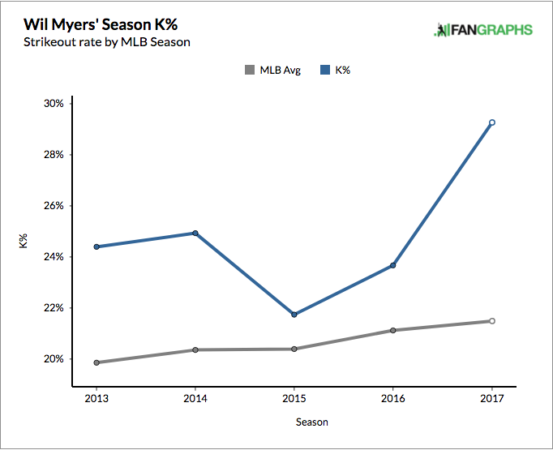
This is a pretty simplistic analysis. Myers strikeout rate has jumped nearly six percent from where it was last year, and almost five percent from his previous career high in 2014. A high strikeout rate doesn’t have to be a bad thing, as is demonstrated with some sluggers who routinely have high strikeout rates, but for a guy who is struggling to hit overall, it does not bode well.
So Myers is striking out more, but we still don’t know the reason for that increase. Let’s look at another graph, this time comparing his swing and contact rates over the course of his career.
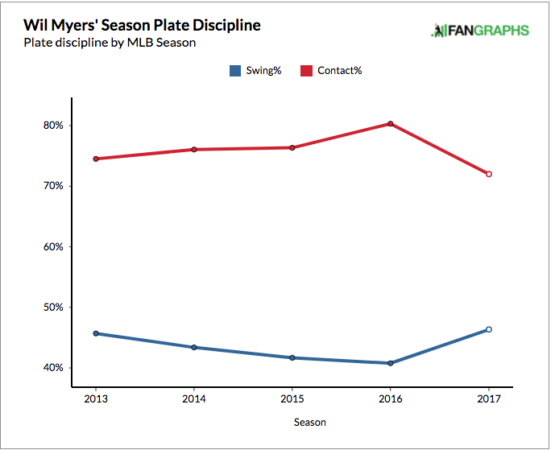
This starts to give us a clearer picture. Not only has Myers been more free-swinging this year, as he has seen a not-so-insignificant five percent increase in his overall swing rate, but he has also, somehow, made less contact than in any other year in his career. In fact, Myers has gone from an 80 percent contact rate all the way down to a contact rate of just 72 percent. Let’s take this one step further.
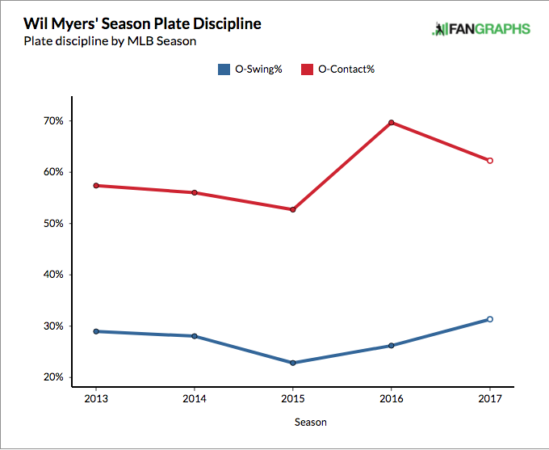
Just looking at pitches outside of the strike zone, we see a similar result. Myers is swinging at more non-strikes and making less contact with the non-strikes he is swinging at. Myers is taking more frequent swings but making contact on those swings less than he ever has before.
Let’s take a look at one more graph that may explain Myers decline in plate discipline.
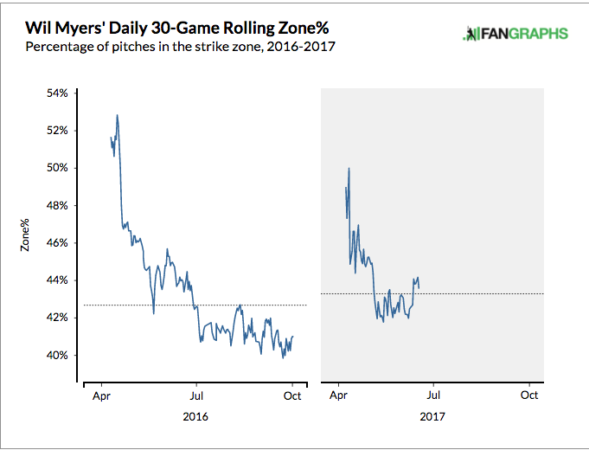
Both of these graphs tell a very similar story. In the first half of 2016, Myers was seeing a lot of pitches in the zone and was having a very successful season. However, once the second half of the season began, Myers saw fewer pitches inside the zone and, as a result, saw a decline in his overall numbers. Myers has seen a similar decline in pitches inside the zone this season, although it has ticked up somewhat recently.
When taken all together, Myers is swinging more often, making less contact, and seeing fewer pitches inside the zone. This has made it easier for pitchers to beat Myers, as he is beating himself by swinging more frequently at pitches that one would consider bad pitches, or pitches outside of the batter’s strike zone.
2. Make more frequent contact
So if Myers is striking out too often, the logical solution is to make more contact right? I understand that is a rather obvious fact, but there is more to it than that. Despite Myers’ decline in performance, he is actually making better contact than he has at any point in his career.
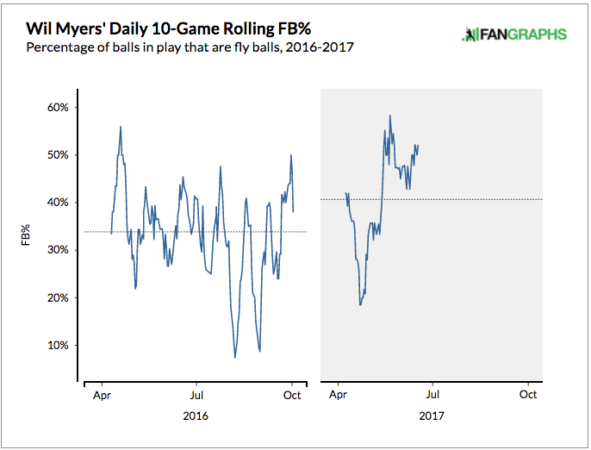
Compared to last season, Myers has hit more fly balls, which usually translates into better results, especially considering baseball is in the midst of a fly ball revolution of sorts. In fact, Myers is actually making more solid overall contact than he was last season.
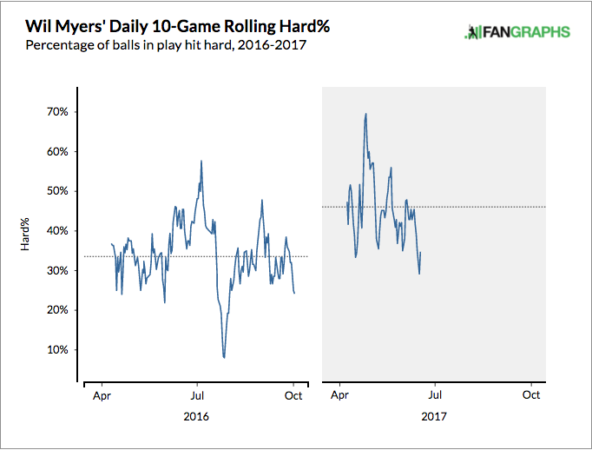
So when Myers has made contact this season, he has been wildly successful, as his average hard hit rate has increased by over 13 percentage points from last year. His soft hit rate has stayed about the same, but he has turned a lot more of his medium hit balls into hard hit balls which has led to much better results on balls he does put in play.
However, there is one problem that has arisen from Myers selling out for more power when he does make contact: infield pop-ups. After having an infield fly ball rate of just six percent last year, Myers infield fly rate has jumped all the way to over 15 percent. Given that infield pop-outs are about the worst type of batted ball a player can have, this hasn’t been a good result for Myers.
Even with the increased pop-ups, Myers has been wildly successful when putting the ball in play. His BABIP has increased by 24 points since last year given the hard contact he is making. Myers has also seen a significant increase in his overall exit velocity on pitches throughout the strike zone, as evidenced by the graph below.
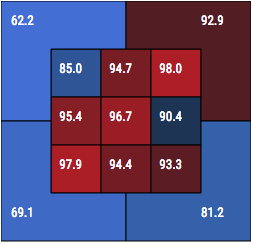
So it’s pretty clear that when Myers does get pitches in the strike zone, he is taking full advantage of them. The problem, as outlined before, is that Myers has seen a decline in his contact rate despite a simultaneous increase in his swing rate. Myers has been better than ever before at crushing pitches inside the zone, but has failed to hold back on pitches outside the zone.
3. Work better from behind in the count
Okay, so Myers is swinging and missing too much and not benefitting from his strong contact numbers because of it. So how can he cut down on strikeouts and start making more contact, and thus start benefitting from the solid contact he is making? It all comes down to how Myers operates when he is working from behind in the count.
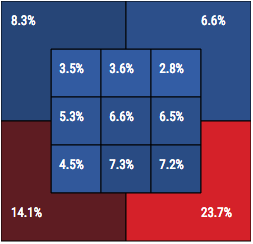
This graph shows the percentage of pitches Myers has seen in different areas of the zone. As was discussed earlier, Myers is seeing fewer pitches inside the zone, and more outside the zone, specifically both down and in and down and away. Of all the locations, Myers has had the most struggles with the pitches he has seen most frequently: the nearly 24 percent of pitches that have been low and away.
To get a better idea, let’s compare Myers’ strike zone plot from this year to a similar one from last year.
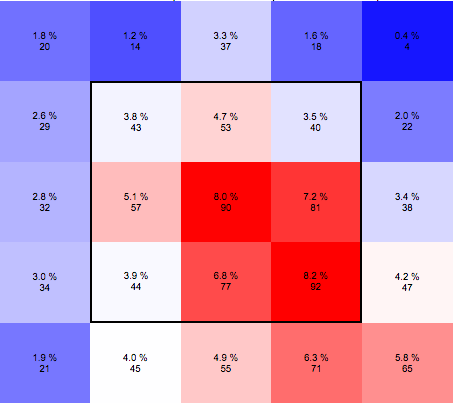
This tells a similar story to the previous graph, Myers is seeing a lot of pitches low and away, and those are precisely the pitches he has most struggled with. Let’s compare that to last year.
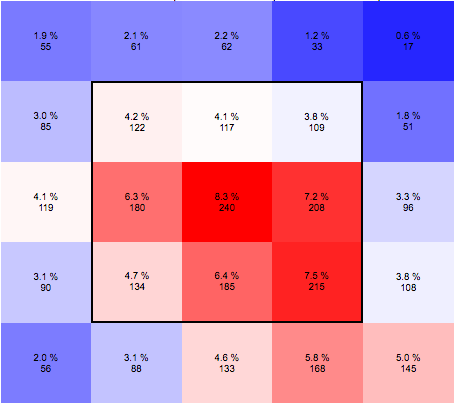
The differences may be subtle, but you can see an increase in pitches down and out of the zone. But let’s get back to the point we are trying to make here. Not only has Myers struggled with pitches outside of the zone, but he has especially struggled when behind in the count.
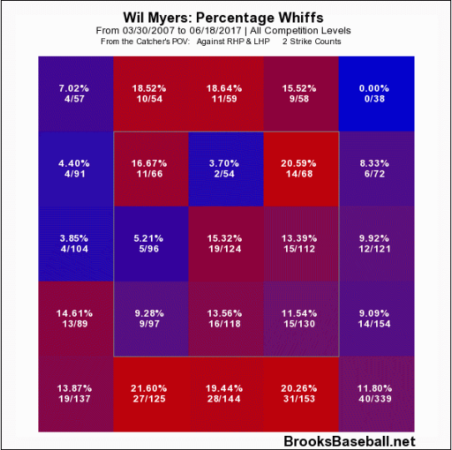
In two-strike counts, whether Myers has one, two, or three balls in the count, he is experiencing rather concerning whiff rates. Even on pitches inside the zone, Myers is struggling to be productive in two-strike counts.
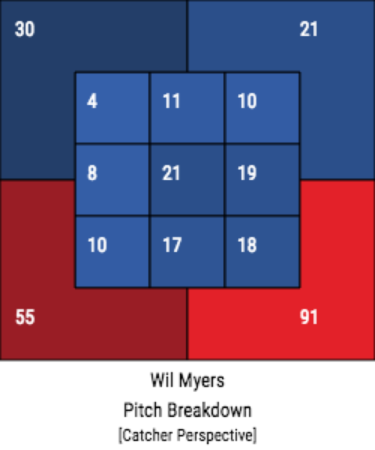
So when Myers is behind in the count he is not getting anything good to hit, and is not able to do anything with the pitches he is getting in those spots outside of the strike zone. Let’s look at one last image to show how Myers has fared in two-strike counts.
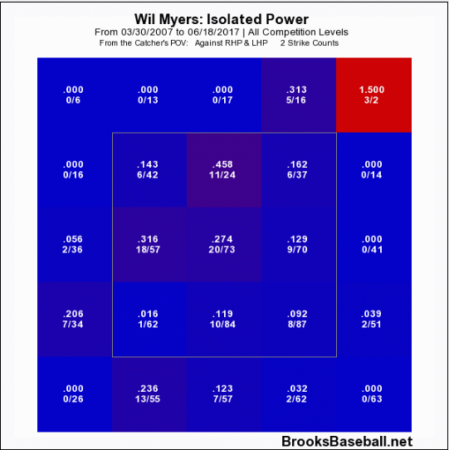
When in two-strike counts, Myers isn’t hitting much, which is further deflating his overall numbers.
So what have we learned? Almost three months into the season, face of the franchise, Wil Myers, has been a major disappointment. The slugger is striking out much too frequently, not making enough contact, and not performing well when behind in the count. On top of all of those struggles, Myers is also struggling to play solid defense over at first base. All in all, Myers has had his fair share of problems early this season.
So where does this leave us? How can Wil Myers fix these problems and become a more effective offensive player? It all starts with his patience. All three of the problems we have discussed come back to Myers swinging too frequently at bad pitches. His zone percentage has seen a big decline, which has caused him to swing at more pitches outside of the zone, problems that only become exacerbated in two-strike counts. It is reassuring that Myers has been making solid contact when he does get the bat on the ball, but he isn’t making contact enough to benefit from that positive.
What Myers needs to do is demonstrate a more patient approach at the plate. If he can cut down his swing rate on pitches outside of the zone, he is going to make pitchers give him better pitches to hit. However, if he keeps swinging at junk outside of the zone with two strikes, pitchers will have no reason to give him any good pitches to hit. And if he doesn’t swing at good pitches, Myers is going to continue to struggle.
There is no easy fix here. As I mentioned at the beginning of this post, baseball is a game of the smallest of small adjustments. For Myers, that is exactly the problem. He is more than capable of being a much more complete offensive player, but he needs to readjust to pitchers giving him fewer pitches inside the zone. If Myers is unable to make those adjustments, he is going to continue to disappoint, and he will never reach his full potential. It’s all on his shoulders. No pressure, kid.
Editorial and Prospect Writer for East Village Times. Twenty-five years young, Patrick has lived in San Diego for his entire life and has been a Padres fan nearly as long. Patrick lives for baseball and is always looking to learn new things about the game he loves through advanced stats.